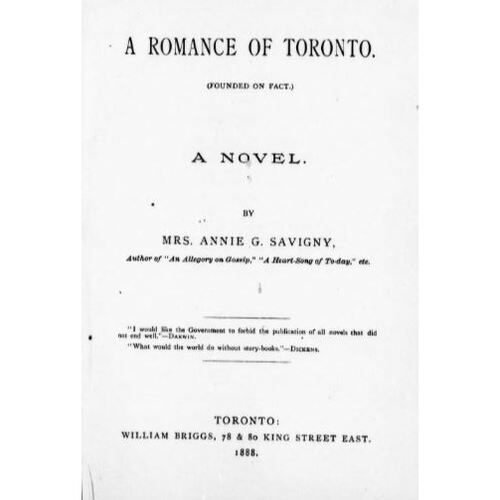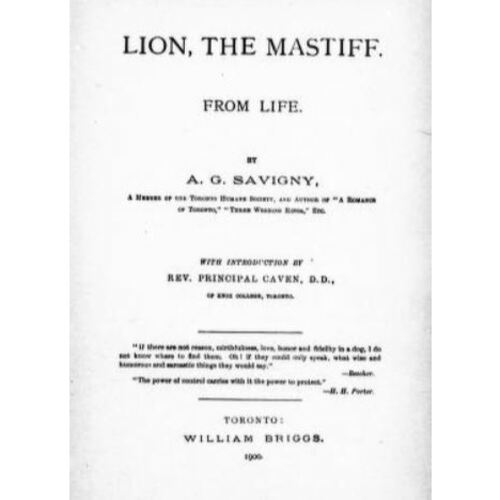
Source: Link
RYAN, ANNE GREGG (Savigny), author; b. likely in the 1830s in England, daughter of James Shepard Ryan and Jane Elizabeth Lopdell; m. after 1871 Hugh Paine Savigny; d. 10 July 1901 in Toronto.
Annie Gregg Savigny, as she was identified on her publications, was recognized by contemporaries as one of Toronto’s more active authors, yet her personal record remains surprisingly uncertain. Details of her birth, immigration, marriage, children (if any), and early places of residence still await discovery. Recent research has disclosed the names of her parents, but also reveals the unreliability of historical documents. Both her death certificate and the record of her interment incorrectly list her place of birth as Toronto; moreover, these cite her age at death as 65 and 75 respectively, when she may have been only about 53.
The paucity of accurate information on Annie reflects the obscurity of women’s lives in the historical record. Far more biographical material survives about her husband, surveyor Hugh Paine Savigny (1821–81), though she was the more notable person. From 1866 to 1880 he is listed as living in Toronto but there is no indication whether he was accompanied by a wife (Annie appears to have been his second, after one Henrietta Simpson, whom he married in 1862). The census of 1881 recorded Scottish-born Hugh Savigny, age 60, and English-born Annie, age 32, living in Port Perry, Ont. The Savigny name reappears in Toronto directories in 1886, when the widowed Annie was living on Bloor Street West. From 1888 she resided on Isabella Street. Although at her death she left only a modest estate, valued at less than $1,800, financial need does not seem to have been her primary reason for writing. The nature of most of her fiction suggests that moral edification was the stronger motive.
Of Savigny’s novels, her first, A heart-song of today, published in Toronto by George Maclean Rose* in 1886, is the most likely to have been aimed at the commercial market. This high-life romance set in London, England, concerns amorous and financial intrigues within the social class that has no better way to amuse itself. A preface, handwritten by the author in the copy possessed by the University of Western Ontario, proclaims her social purpose: she warns that “the ‘unruly member’ set in motion by that ancient firm of ‘envy hatred & malice’ (with jealousy [also] as motive power) is more to be dreaded as an instrument of evil than dynamite in any form.” Her next book, A romance of Toronto (Toronto, 1888), published by William Briggs*, is specifically rooted in the city she knew best. Today it is of more interest for its local references and celebration of late-19th-century Toronto than for its unsubtle and unlikely double plot, one strand concerning a woman trapped by an unwanted promise of marriage, the other recounting the attempted duping of a naïve heir by unscrupulous relatives.
Also distinctly set in Toronto are Savigny’s two juvenile books written on behalf of the Toronto Humane Society, in which she focuses on the plight of abused animals and “the barbarous cruelties to which they are subjected by reason of the faithlessness of man to his trust.” Lion, the mastiff (1895), again published by Briggs, enjoyed at least two reprints (1897 and 1900) and would have been welcomed by the same readers who made a best seller of Beautiful Joe (Philadelphia, 1893), by Margaret Marshall Saunders*, the best known of Canada’s early animal rights novelists. Like Saunders, Savigny allows her animal characters to speak directly to their young potential protectors and advises children to join the Band of Mercy. This message is repeated in Dick Niven and his horse Nobby (Toronto, 1898); the work’s subtitle – lantern slide lecture teaching kindness to animals – indicates its didactic purpose.
During her final years Savigny also contributed to several local periodicals. One source claims that she “wrote extensively on astronomical subjects for the Toronto Astral Society.” This organization has now been identified as the Astronomical and Physical Society of Toronto, and its published Transactions record her serious interest in science. Her many presentations included papers on the planet Mars (1897) and on planetary observations taken at Lowell Observatory in Flagstaff, Ariz. (1899, 1900). Savigny’s will confirms the social values proclaimed in her writing; her major beneficiaries included the Toronto Humane Society, the Lord’s Day Alliance, the Toronto General Hospital, and John Joseph Kelso* (founder of the Children’s Aid Society) for his work among children.
In addition to the works mentioned in the text, Annie Gregg Ryan Savigny is the author of “An allegory on gossip,” Lake Magazine (Toronto), 1 (1892): 245–47, and Three wedding rings (Toronto, 1892). A romance of Toronto (founded on fact): a novel was reprinted (Toronto and Buffalo, N.Y., 1973).
AO, RG 8, I-6-B, 63: 98; RG 22, ser.305, no.14843; RG 80-8, no.1901-002927. Globe, 12 July 1901: 10. Toronto Daily Star, 12 July 1901: 2. Assoc. of Ontario Land Surveyors, Annual report (Toronto), 1935: 117–18. A bibliography of Canadian fiction (English), comp. L. E. Horning and L. J. Burpee (Toronto, 1904), 55. J. A. Smith, “The scientific work of ‘Annie Gregg Ryan-Savigny”’ (unpublished paper prepared for the Institute for the History and Philosophy of Science and Technology, Univ. of Toronto, 1992).
Cite This Article
Carole Gerson and Julian A. Smith, “RYAN, ANNE GREGG (Savigny),” in Dictionary of Canadian Biography, vol. 13, University of Toronto/Université Laval, 2003–, accessed October 21, 2025, https://www.biographi.ca/en/bio/ryan_anne_gregg_13E.html.
The citation above shows the format for footnotes and endnotes according to the Chicago manual of style (16th edition). Information to be used in other citation formats:
| Permalink: | https://www.biographi.ca/en/bio/ryan_anne_gregg_13E.html |
| Author of Article: | Carole Gerson and Julian A. Smith |
| Title of Article: | RYAN, ANNE GREGG (Savigny) |
| Publication Name: | Dictionary of Canadian Biography, vol. 13 |
| Publisher: | University of Toronto/Université Laval |
| Year of revision: | 1994 |
| Access Date: | October 21, 2025 |






